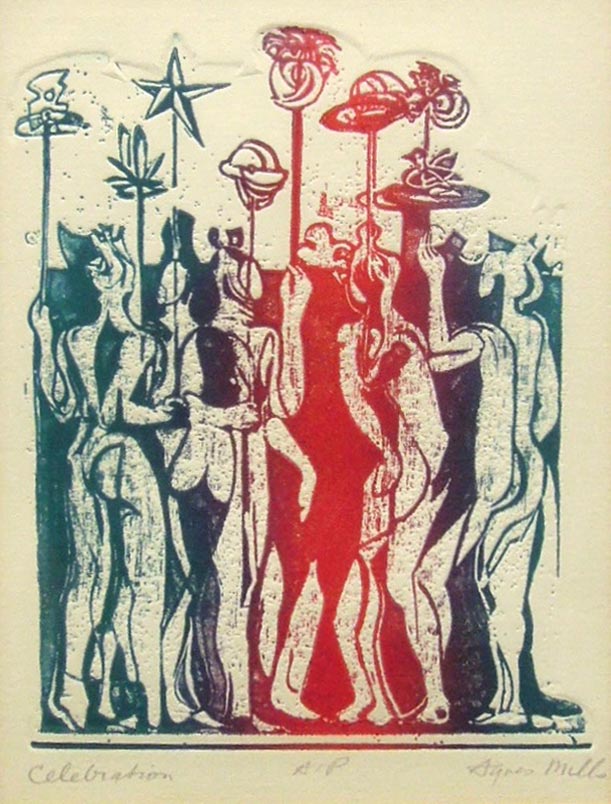59. Agnes Karlin Mills
| Life Dates | 1915-2008 |
| Place of Birth | Brooklyn, NY, USA |
| Place of Death | Santa Rosa, CA, USA |
| Birth Name | Agnes Karlin |
Agnes Karlin was the eldest child born in Brooklyn, New York, to Herman and Celia Karlin, who had both fled Russia to escape religious persecution. In 1931, she enrolled in the Woman’s Art School at the Cooper Union and completed a degree in Pictorial Design in June 1935.1 Immediately after graduating, she was hired to work on the Index of American Design, a project supported by the Works Progress Administration.2 After the Index, she worked in other WPA-FAP-sponsored programs like the easel and mural divisions and had exposure to its Design Laboratory—a school modeled on the Bauhaus—and screen printing under instruction from Anthony Velonis.3 In 1936, she married Saul Mills (1910-1988), a newspaper reporter who became an important labor organizer and eventually secretary-treasurer of the New York CIO Council.4 Agnes Mills largely put her art career on hold while the couple’s two daughters—born in 1942 and 1946—were young. In her autobiographical writings, Mills recalls working at Atelier 17’s “wonderful Eighth Street workshop” and learning the “magic of viscosity printing.”5 No prints from this period have survived, and it is likely Mills was only briefly at Atelier 17. Yet she made important connections there, which shaped the direction of her career. In addition to Atelier 17, Mills had some previous experience in printmaking with Velonis and though private study with Elizabeth Olds and Harry Gottlieb. She returned to printmaking during the 1970s, working in the Queens-based printmaking studio of Atelier 17 alumna Ruth Leaf and traveling to Paris to study with Krishna Reddy at Atelier 17’s Paris workshop. Through Leaf, she joined a network of printmakers active on Long Island (the Millses had moved to Great Neck around 1958), becoming a longtime member of the mostly female-operated cooperative gallery in Port Arthur called The Graphic Eye and joining the Great Neck Printmakers.6 Around this time, she also became artist-in-residence for modern choreographer Alwin Nikolais, a position that lasted for approximately fifteen years, and observed rehearsals for several other contemporary dance troupes. Her prints from this period, created using Atelier 17’s color viscosity technique or a proprietary color-copy process she termed Millagraphs, capture the movement and rhythm of dance.7
Archives
Agnes Mills papers, 1948-1999, bulk 1974-1993, Archives of American Art/Smithsonian Institution.
Notes
- Brenda Ferebee, registrar at Cooper Union, confirmed Agnes Karlin’s attendance records, email to Christina Weyl, May 10, 2017. ↩
- The National Gallery of Art, Washington, DC, which holds the archives for the Index of American Design, has seven of Agnes Karlin’s drawings. ↩
- Agnes Mills, “Reminiscences of the W.P.A. Artists Project,” ca. 1980s, Agnes Mills papers, 1948-1999, bulk 1974-1993, series 3, Archives of American Art/Smithsonian Institution [henceforth AMP]. Mills notes in this document that she made probably ten or more screenprints of Coney Island but was unsure what happened to them. ↩
- Saul Mills’s papers are located at the Tamiment Library and Robert F. Wagner Labor Archive, New York University, WAG.075. Box 1, folders 4-7 contain letters between Saul Mills and Agnes Karlin written during their courtship and marriage. ↩
- Mills, “Reminiscences of the W.P.A. Artists Project,” AMP. ↩
- For more about The Graphic Eye, “New Co-Op Gallery Opens,” New York Times, November 17, 1974, 145. See also “Great Neck Printmakers Art Exhibit,” March 15-April 22, 1982, AMP. ↩
- Folder 3 in AMP includes several artist’s statements and a credo. ↩


